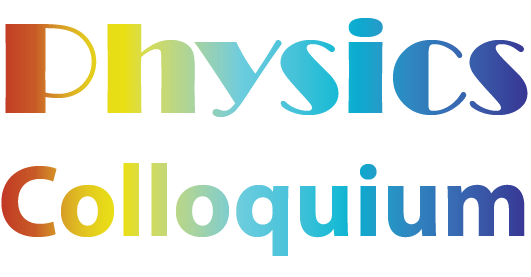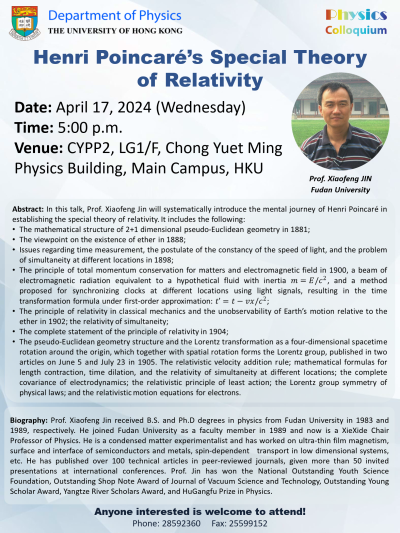
The Physics Colloquium has been arranged regularly since the fall semester of 2021. The detailed schedule and talk information of this semester are as follows.
For inquiries or suggestions of future speakers, please contact the colloquium working group (Prof. Jane Lixin Dai, Prof. Tran Trung Luu, Prof. Yanjun Tu, Prof. Chenjie Wang, and Prof. Shizhong Zhang).
Attosecond Physics with Sculptured Circular Light Fields
Speaker: Prof. Yunquan LIU
Affiliation: Peking University
Date: January 24, 2024 (Wednesday)
Time: 5:00 p.m.
Venue: CYPP2, LG1/F, Chong Yuet Ming Physics Building, Main Campus, The University of Hong Kong
Poster: Download
Abstract:
Laser-induced electron tunneling, triggering a broad range of ultrafast phenomena such as the generation of attosecond light pulses, photoelectron diffraction and holography, has laid the foundation of strong-field physics and attosecond science. Using the attoclock constructed by single-color elliptically polarized laser fields, previous experiments have measured the tunneling rates, exit positions, exit velocities and delay times for some specific electron trajectories, which are mostly born at the field peak instant where the laser electric field and the formed potential barrier are stationary in terms of the derivative versus time. From the view of the wave-particle dualism, the electron phase under a classically forbidden, tunneling barrier has not been measured, which is at the heart of quantum tunneling physics. Here we present a robust measurement of tunneling dynamics including the electron sub-barrier phase and amplitude. We combine attoclock technique with sculptured circular fields to accurately calibrate the angular streaking relation and to probe the non-stationary tunneling dynamics by manipulating a rapidly changing potential barrier. The sculptured attoclocks provides a general time-resolved approach to access the underlying quantum dynamics in intense-light-matter interactions.
Key Reference:
1. M. Han et al., “Attoclock Photoelectron Interferometry with Two-Color Corotating Circular Fields, to Probe the Phase and the Amplitude of Emitting Wave Packets,” Phys. Rev. Lett. 120, 073202 (2018).
2. M. Han et al., “Unifying Tunneling Pictures of Strong-Field Ionization with an Improved Attoclock” Phys. Rev. Lett. 123, 073201 (2019).
3. P. Ge et al., “Universal Description of the Attoclock with Two-Color Corotating Circular Fields,” Phys. Rev. Lett. 122, 013201 (2019).
4. Y. Fang et al. “Photoelectronic mapping of the spin–orbit interaction of intense light fields.” Nat. Photonics (2020). https://doi.org/10.1038/s41566-020-00709-3
5. M. Han et al., "Complete characterization of sub-Coulomb-barrier tunneling with phase-of-phase attoclock," Nat Photonics 15, 765-771(2021).
Does galaxy interaction affect the black hole growth in the galaxy center? Insights from statistical and case studies
Speaker: Yu Sophia DAI
Affiliation: National Astronomical Observatories of China
Date: February 21, 2024 (Wednesday)
Time: 5:00 p.m.
Venue: CYPP2, LG1/F, Chong Yuet Ming Physics Building, Main Campus, The University of Hong Kong
Poster: Download
Abstract: The interaction of galaxies is known to regulate the star-formation activities in the merging systems, or galaxy pairs, however, whether and how such interactions affect the central supermassive black hole (aka. active galactic nuclei---AGN activity) is still under debate. Controversies exist as to whether AGN activities are enhanced or suppressed during the different merging phases. In addition, during the merging process, whether AGNs boost or suppress the star formation through the so-called `positive’ or `negative’ feedback is still an open question. The answer to this question involves understanding of the physical properties of galaxy pairs in various scales, from the supermassive black hole at the galactic center to ionized gas, molecular gas, atomic gas, and the dust contents throughout the galaxies and towards their close vicinities. Based on statistical samples of emission line selected galaxy pairs with MaNGA and HST, we study the AGN fraction evolution in various merger cases, and compare to isolated galaxies the global and resolved stellar mass, star formation rate, emission line, and AGN luminosity properties. Then through case studies of the HI environment of galaxy pairs with FAST, we further demonstrate the power to combine observations of significantly different scales and resolutions, and their insights on the role of AGNs during galaxy interaction.
Non-thermal Coronal Magnetic Activity in Nearby Seyferts
Speaker: Yoshiyuki INOUE
Affiliation: Department of Earth and Space Science, Osaka University
Date: February 28, 2024 (Wednesday)
Time: 5:00 p.m.
Venue: CBC, LG1/F, Chow Yei Ching Building, Main Campus, The University of Hong Kong
Poster: Download
Abstract: Central supermassive black holes of active galactic nuclei (AGNs) host hot plasma with a temperature of 10^9 K, namely coronae. Like the Sun, black hole coronae are theoretically believed to be heated by their magnetic activity. However, such activity has not been observed yet. In this talk, Prof. Inoue will report the detection of coronal magnetic activity in nearby AGNs using ALMA (radio telescopes). The coronal magnetic fields are typically ~10 G on scales of ~40 Schwarzschild radii. The measured magnetic field is weaker than the theoretical expectation, requiring a new corona heating mechanism. Prof. Inoue will also discuss particle acceleration processes in the coronae of Seyferts, which may be the production sites of the high energy neutrinos seen by IceCube.
Unraveling the Origins of Elements: Bridging Nuclear Theory with Machine Learning
Speaker: Haozhao LIANG
Affiliation: The University of Tokyo
Date: March 6, 2024 (Wednesday)
Time: 5:00 p.m.
Venue: CYPP3, LG1/F, Chong Yuet Ming Physics Building, Main Campus, The University of Hong Kong
Poster: Download
Abstract: Understanding the origin of elements in the universe stands as one of the paramount scientific questions. In particular, the nucleosynthesis of heavy elements spanning from iron to uranium entails thousands of highly neutron-rich isotopes, surpassing current experimental capabilities for direct measurements. Consequently, the systematic and self-consistent computation and prediction of the physical properties of neutron-rich isotopes have emerged as crucial frontiers in both nuclear physics and nuclear astrophysics. In this colloquium, Prof. Liang will discuss the theoretical investigations on nuclear mass and beta-decay half-lives, while exploring the potential roles and effectiveness of machine learning methodologies within this cutting-edge research domain.
Key Reference:
1. Z. M. Niu and H. Z. Liang, Phys. Lett. B 778, 48 (2018)
2. Z. M. Niu and H. Z. Liang, Phys. Rev. C 106, L021303 (2022)
3. F. Minato, Z. M. Niu, and H. Z. Liang, Phys. Rev. C 106, 024306 (2022)
4. T. C. Yiu, H. Z. Liang, and J. Lee, Chin. Phys. C 48, 024102 (2024)
Cosmology with Massive Neutrinos
Speaker: Jia LIU
Affiliation: Kavli IPMU in the University of Tokyo
Date: March 20, 2024 (Wednesday)
Time: 5:00 p.m.
Venue: CBC, LG1/F, Chow Yei Ching Building, Main Campus, The University of Hong Kong
Poster: Download
Abstract: Ghostly neutrino particles continue to bring surprises to fundamental physics, from their existence to the phenomenon of neutrino oscillation, which implies their nonzero masses. Their exact masses, among the most curious unknowns beyond the Standard Model of particle physics, can soon be probed by the joint analysis of ongoing and upcoming cosmological surveys including Rubin LSST, Euclid, Roman, DESI, PFS, Simons Observatory, CMB-S4, and LiteBRID. In this talk, I will discuss ongoing works studying the effects of massive neutrinos and will draw a roadmap towards discovering the neutrino mass over the next decade.
Push femtosecond laser to extreme light for attosecond generation
Speaker: Zhiyi WEI
Affiliation: Institute of Physics, Chinese Academy of Sciences
Date: April 3, 2024 (Wednesday)
Time: 5:00 p.m.
Venue: CYPP2, LG1/F, Chong Yuet Ming Physics Building, Main Campus, The University of Hong Kong
Poster: Download
Abstract: With the remarkable progresses in ultrafast laser technology, not only the laser power has broken 10 PW based on Chirped Pulse Amplification (CPA), but the duration was also pushed to attosecond scale, both won the Noble prize in physics in 2018 and 2023 respectively. To pursuit extreme light pulse and trigger the emerging applications in ultrafast dynamics, high field physics etc, we developed a series of ultrafast laser technologies such as generation of few cycles laser pulses, amplification of high power femtosecond lasers and frequency conversion toward infrared and XUV. Pulse duration shorter than 86 as was obtained from our extreme laser facilities. In this talk I will give a brief introduction for the results and facilities.
Henri Poincaré’s Special Theory of Relativity
Speaker: Xiaofeng JIN
Affiliation: Fudan University
Date: April 17, 2024 (Wednesday)
Time: 5:00 p.m.
Venue: CYPP2, LG1/F, Chong Yuet Ming Physics Building, Main Campus, The University of Hong Kong
Poster: Download
Abstract:
In this talk, Prof. Xiaofeng Jin will systematically introduce the mental journey of Henri Poincaré in establishing the special theory of relativity. It includes the following:
- The mathematical structure of 2+1 dimensional pseudo-Euclidean geometry in 1881;
- The viewpoint on the existence of ether in 1888;
- Issues regarding time measurement, the postulate of the constancy of the speed of light, and the problem of simultaneity at different locations in 1898;
- The principle of total momentum conservation for matters and electromagnetic field in 1900, a beam of electromagnetic radiation equivalent to a hypothetical fluid with inertia m=E/c2, and a method proposed for synchronizing clocks at different locations using light signals, resulting in the time transformation formula under first-order approximation: t’=t-vx/c2;
- The principle of relativity in classical mechanics and the unobservability of Earth’s motion relative to the ether in 1902; the relativity of simultaneity;
- The complete statement of the principle of relativity in 1904;
- The pseudo-Euclidean geometry structure and the Lorentz transformation as a four-dimensional spacetime rotation around the origin, which together with spatial rotation forms the Lorentz group, published in two articles on June 5 and July 23 in 1905. The relativistic velocity addition rule; mathematical formulas for length contraction, time dilation, and the relativity of simultaneity at different locations; the complete covariance of electrodynamics; the relativistic principle of least action; the Lorentz group symmetry of physical laws; and the relativistic motion equations for electrons.
Key References: 庞加莱的狭义相对论, 金晓峰, 2022-2023年《物理》





